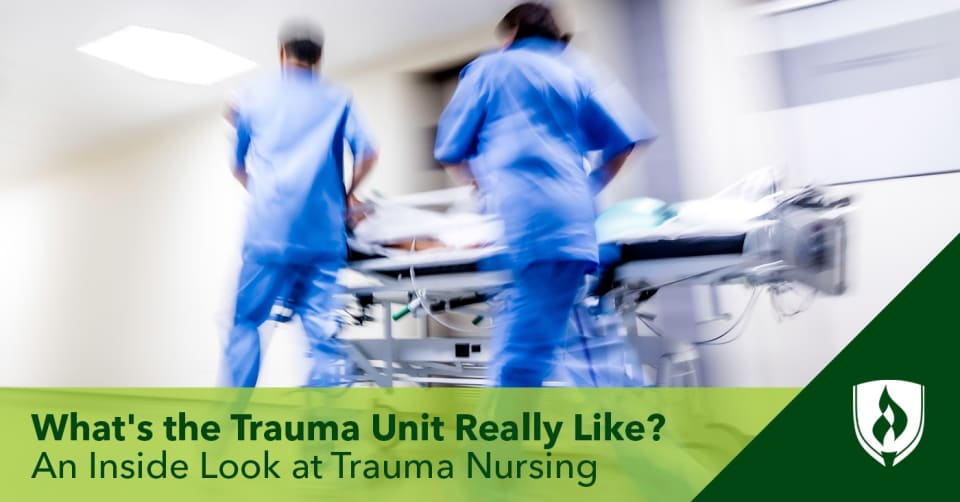What's the Trauma Unit Really Like? An Inside Look at Trauma Nursing
By Brianna Flavin on 10/11/2021
The word “nursing” covers a staggering number of roles, degrees, specialties and skills. While this makes it difficult to decide on your specific career path, it also means nurses have a very good chance of finding the type of work they like best.

Some nurses thrive in the daily bustle of a clinic. Some nurses love the outpatient centers where they can build long-term relationships with a patient. Some nurses are built for the intensity and urgency of emergencies.
Trauma nurses are those kinds of people.
“I love working the trauma units because it keeps me on my toes,” says trauma nurse and author, Grover Nicodemus Street. “Every day is different, and I can make a difference if a person lives or not.”
If you’ve been considering different areas of nursing and different types of nurses, you might wonder what working in the trauma unit is really like. If so, read on! This may be the nursing specialty you have been looking for.
What is the trauma unit?
The trauma unit (or trauma center) is typically a part of the emergency floor in a hospital that deals with severe injuries. These care teams treat patients who have severe injuries that are likely to threaten life and limb. Treating these types of severe injuries requires expertise in multiple disciplines and a comprehensive suite of emergency medical services. These unique needs and circumstances have led to trauma becoming its own unit and specialty in many healthcare facilities.
Trauma center levels explained
Trauma centers have “levels” that indicate which resources they have and what they can provide. For a full breakdown, check out the American Trauma Society’s (ATS) explanation of trauma center levels.1 As a very brief overview, Level 1 trauma centers have the most comprehensive care and Level 5 centers only offer stabilization and transfer to a higher level facility.
- Level 1 centers provide complete care for every aspect of injury, from prevention to rehab.
- Level 2 centers can begin treatment for all injuries, but may not have comprehensive care.
- Level 3 centers provide assessment, resuscitation, surgery, intensive care and stabilization.
- Level 4 centers provide advanced trauma life support (ATLS) before transferring patients to a higher-level trauma facility. They can also evaluate, stabilize and diagnose injured patients.
- Level 5 centers provide initial evaluation, stabilization and diagnostic capabilities and prepare patients for transfer.
The trauma unit vs. ER/ED
“Usually the trauma center is in an ED (emergency department),” Street says. “Some nurses are assigned to the specific trauma room.” Trauma units deal with severe injury related to blunt force, accidents and violence. Emergency departments treat life-threatening medical conditions, illness and disease along with injuries like broken bones.
One reason many hospitals create distinctions between Emergency and Trauma is to have a built-in system where patients who are hurt or very sick can go to one place for diagnosis, while other patients in imminent danger of death can receive life-saving care. If an emergency department is crowded, a patient from a bad car crash could die while waiting to get in. Separate units dedicated to trauma can streamline the process.
Let’s take a look at how this may break down.
Trauma centers typically treat:2
- Gunshot and stab wounds
- Major burns
- Traumatic car crash injuries
- Blunt trauma
- Brain injuries
Emergency rooms typically treat:2
- Broken bones
- Fainting or loss of consciousness
- Heart attacks
- Less severe burns
- Strokes
- Severe vomiting, stomach pains and/or diarrhea
What types of patients do trauma nurses work with?
Since trauma units are about injury more than illness—trauma nurses work with patients of all ages and backgrounds. Since the trauma unit is usually dedicated to life-threatening problems, trauma nurses likely see a higher percentage of fatalities than other branches of nursing. The German Trauma Society conducted a two-year study of trauma departments and found that about 8% of patients admitted to intensive care units died during their stay.3
Patients who arrive in a trauma unit may have experienced an accident like a catastrophic fall or a car crash. They may have experienced violence like shooting, stabbing or abuse. Trauma nurses can expect to witness very rough situations that can be mentally taxing. Simply put, it’s not for everyone—but some healthcare professionals do thrive in this environment.
What is working in the trauma unit like?
“We see all sorts of patients that have gunshot or stab wounds, falls from all sorts of heights, car accidents and roll overs, and accidental amputations of any limb,” Street says. “My typical day is caring for all these kinds of patients and more.” He says their unit has lately seen an uptick in COVID-19 patients as well.
With patients facing such extreme circumstances, you may be wondering what trauma unit nurses enjoy about their work.
“The adrenaline rush is what I like the most when working in this high-paced, high-acuity location,” Street says. “It feels good that we are all working as hard as we can, and that fast pace makes a difference in whether this person lives or not.”
Street recalls a time earlier in his career where he worked in shock trauma and treated a 40-year-old man who got hit by a truck and sustained horrendous injuries.
Street was part of the team, starting IVs and giving 30 units of blood as fast as possible. “We were squeezing the blood bags into this patient with our hands, getting him as stable as possible. Ultimately, he survived long enough for his family to arrive to say goodbye.” Even though the patient died a few days later, Street felt proud that their work allowed him a dignified death near his loved ones.
Sometimes the job is deeply satisfying, even when you can’t save someone. But Street says it can be hard to mentally prepare for each day with no idea of what is going to come through the door. “A stab wound could be a knife in a gut or a knife in someone’s head into their brain.”
And some cases may stick with you long after the shift is over. “A child drowning victim is the most challenging, emotionally, for me, as many times it could have been avoided,” Street says.
As you can see—the work of a trauma unit nurse has an incredible range of highs and lows that you won’t typically find in most nursing roles.
How to become a trauma nurse
The first step to trauma nursing is becoming a registered nurse (RN). To become an RN, you need to complete either an Associate’s Degree in Nursing or a Bachelor of Science in Nursing program, pass the NCLEX-RN® exam and meet all other state licensure requirements.
After you become a registered nurse, it can help to obtain professional certifications in critical care (CCRN) or trauma certified registered nursing (TCRN) and advanced cardiac life support (ACLS). Depending on your employer, you may also need certification in specific areas like pediatrics or emergency nursing.
“I hold many certificates which makes me versatile in hospitals. This enables me to pick my station instead of the other way around,” Street says.
Is trauma nursing for you?
If you aren’t great with blood or are concerned about your work-life balance in an environment built around trauma, this particular branch of nursing may not be for you. But if you work well under pressure and could see yourself thriving in this high-stakes career, you could have a meaningful career as a trauma nurse on your horizon.
And getting there might be easier than you think! Nursing education has never been more flexible. Check out our article, “How to Become an RN Fast: 3 Potential Paths to Pursue” for some ideas on how your journey into trauma nursing could begin.
Related Articles:
- Flight Nursing: Exploring a Sky-High Job for the Adventurous Nurse
- What Is a Rapid Response Nurse? A Closer Look at These Ready Responders
1“Trauma Center Levels Explained” American Trauma Society. [accessed September, 2021] https://www.amtrauma.org/page/traumalevels
2“What Is a Trauma Center? Trauma Center Levels: ER vs. Trauma Center” University of Pittsburgh Medical Center Health Beat. May 26, 2016 [accessed September, 2021]https://share.upmc.com/2016/05/er-vs-trauma-center-levels/
3Uwe Hamsen et al. “Mortality in severely injured patients: nearly one of five non-survivors have been already discharged alive from ICU” BMC Anesthesiology, 20 no. 243. September 23, 2020. [accessed September, 2021] https://bmcanesthesiol.biomedcentral.com/articles/10.1186/s12871-020-01159-8




